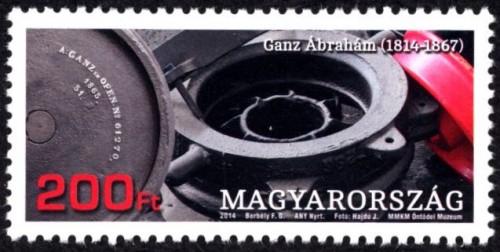
1. MAGYAR - 200 ÉVE SZÜLETETT GANZ ÁBRAHÁM Bélyeg vásárlás >>
2. ENGLISH - Ábrahám Ganz was born 200 years ago - Order stamp >>
1. MAGYAR - 200 ÉVE SZÜLETETT GANZ ÁBRAHÁM
A Magyar Posta alkalmi bélyeg kibocsátásával köszönti Ganz Ábrahám (1814-1867), a magyar ipar úttörője születésének bicentenáriumát. A bélyegképen Ganz Ábrahám szabadalma alapján gyártott kéregöntésű vasúti kerék gyártási folyamatának részlete látható. Hajdú József művészfotóinak felhasználásával, Borbély Ferenc Gusztáv grafikusművész tervei alapján az ANY BiztonságiNyomda gyártotta. A bélyeghez és az alkalmi borítékhoz forrásanyagot a MMKM Öntödei Múzeuma biztosított. Az újdonság november 6-tól kapható a nagyobb postákon valamint a Filapostán, de megrendelhető a Magyar Posta internetes áruházából is.
A mesteremberből lett vállalkozó Ganz Ábrahám Svájcból érkezett a reformkori Magyarországra. Találmányával, a kéregöntésű vasúti kerékkel forradalmasította a vasúti kerék öntését, ezáltal megalapozva egy biztonságosabb és jobb közlekedés alapjait. Munkájának sikerét jelezte, hogy 1842-ben az Első Magyar Iparmű kiállításon a Hengermalom öntödéjének termékeivel ezüstérmet nyert. 1845-ben önállósította magát. 1867. november 23-án ünnepelték a százezredik kéregöntésű kerék gyártását, amelynek alkalmából vacsorát adott minden alkalmazottja és családtagjai részére. Életében sokat fordított szociális célokra, üzemében Magyarországon akkor egyedülálló nyugdíjas, és betegpénztárt létesített. Megtakarításaiból telket vásárolt Budán a Vizivárosban, és elkezdte saját öntödéjében tömegcikkek és közszükségleti cikkek gyártását. Mint tehetősebb üzletember 1858 körül újabb telket vásárolt a környéken, és ekkor építette fel már sokkal korszerűbb öntödéjét, mely a mai Bem József utcában áll, és falai között ma a Magyar Műszaki és Közlekedési Múzeum keretében működő Öntödei Múzeum található. Az épület az akkori időszak tipikus gyárépülete. A rácsos fatartókra szerkesztett sédtető ablakai egész nap biztosították az épület természetes megvilágítását. Ez a legrégebbi ilyen tetőszerkezet, ami megmaradt hazánkban. Első írásos emléke egy Vasárnapi Újság 1862-ből való cikkéből származik, melyben részletesen leírják, hogy öt nagy- és nyolc kisebb olvasztó található az épületben, és hetenként több ezer mázsányi „öntöttvasmű” készül. Az épületben 1964-ig öntöde működött. 1969-ben csekély átalakítást követően mint múzeum nyitotta meg kapuit. Az Öntödei Múzeum kertjében, az Öntészeti Pantheonban található – az alkalmi borítékot is díszítő – Ganz Ábrahám 1968-ban bronzból készült mellszobra, mely Csernyei Kaltenbach István alkotása. (Forrás: MMKM Öntödei Múzeum, sztnh.gov.hu/feltalalok/ganz.html)
Forrás: Posta
2. ENGLISH - Ábrahám Ganz was born 200 years ago
Magyar Posta is issuing a commemorative stamp to mark the bicentenary of the birth of Ábrahám Ganz (1814-1867), a pioneer of Hungarian industry. The stamp design shows a detail of the production process of the hard-cast railway carriage wheel made based on a patent by Ábrahám Ganz. The stamp was designed by the graphic artist Ferenc Gusztáv Borbély using photographs by József Hajdú and produced by the ANY Security Printing Company. The source material for the stamp and the first day cover was provided by the Foundry Museum of the Hungarian Museum of Science, Technology and Transport. The new stamp will be available at large post offices and Filaposta in Hungary from 6 November, but may also be purchased from Magyar Posta’s online store.
The craftsman cum entrepreneur Ábrahám Ganz arrived in Reform-Age Hungary from Switzerland. His invention, hard casting, revolutionised the production of railway wheels, thus laying the foundations for a safer and better means of transport. The silver medal Ganz won at the First Hungarian Industrial Exhibition in 1842 for the products of the foundry of the rolling mill where he was employed was an indication of the success of his work. In 1845 he became independent. The production of the one hundred thousandth hard-cast railway wheel was celebrated on 23 November 1867. To mark the occasion, he gave a dinner for all his employees and their family members. Ganz devoted large amounts to social purposes throughout his life and established a fund for pensioners and the sick in his factory which was unique in Hungary at the time. From his savings he purchased a plot in Buda and commenced the production of commodity and consumer goods in his own foundry. As a wealthy businessman, he bought another nearby plot in today’s Bem József Street in about1858, where he built a foundry which was much more modern. Today this building houses the Foundry Museum of the Hungarian Museum of Science, Technology and Transport. The foundry was constructed in the style typical of factory buildings of the period. The lights of the saw-tooth roof supported by wood trusses provided natural lighting for the building throughout the day. This is the oldest roof of its kind to have survived in Hungary. The first written record about it appeared in the newspaper Vasárnapi Újság from 1862. The article described in detail that there were five large and eight small smelting furnaces in the building, producing several hundred thousand cast iron products a week. A foundry operated in the building until 1964. Following some minor changes, the building opened its doors as a museum in 1969. The Foundry Pantheon in the garden of the Foundry Museum houses the bronze bust of Ábrahám Ganz made by the sculptor István Cserenyei Kaltenbach in 1968, which adorns the first day cover. (Source: Foundry Museum of the Hungarian Museum of Science, Technology and Transport, sztnh.gov.hu/feltalalok/ganz.html)










